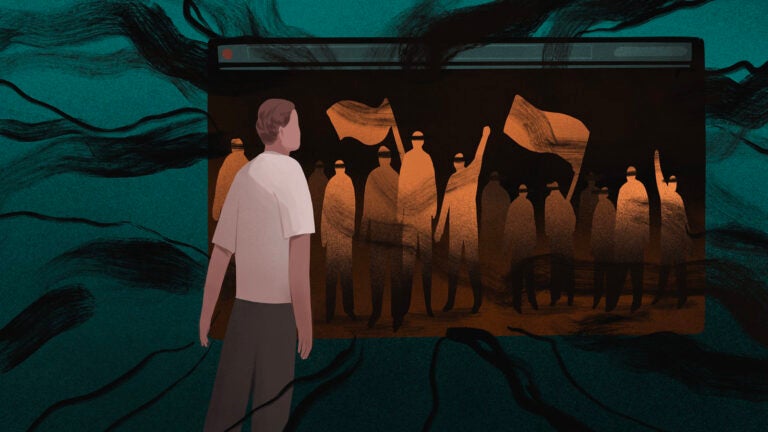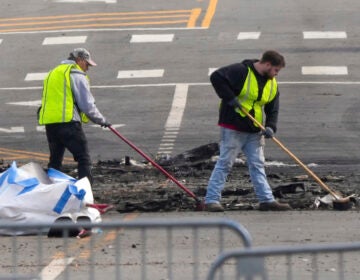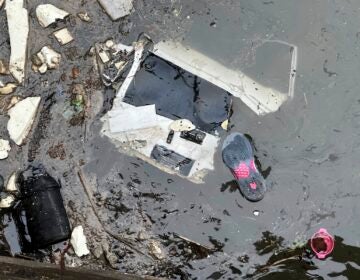What do domestic extremists and ISIS have in common? A social media strategy

ISIS and domestic extremism in the U.S. are driven by very different ideologies, but the process by which young people are radicalized is remarkably similar. (Nicole Xu for NPR)
Before Jan. 6, the run-ins Bruno Cua, 18, had had with police in his small town of Milton, Ga., were mostly of the scofflaw variety.
He blew an air horn in the school parking lot — that ended with a citation for disturbing the peace. He had been on the receiving end of multiple warnings for trespassing — he insisted on cutting through someone else’s land to go fishing. And, according to court documents, his all-terrain vehicle was also a source of consternation: Police kept telling him to stop driving it on roads where it didn’t belong.
“Cua has…exhibited a reluctance to abide by the rules and to follow the directions of law enforcement and other authorities,” wrote U.S. District Court Judge Randolph D. Moss, in a court order last week. “Cua’s criminal history is not spotless, but neither is it substantial.”
In the run-up to the 2020 presidential election, according to court documents filed by both the prosecution and the defense, Bruno Cua’s teenage antics were replaced by something more consequential: far-right conspiracies. They say his world began revolving around the misinformation he picked up on websites and Facebook pages. And the falsehoods he discovered profoundly affected him. Anyone who was watching for it could find it in his social media posts.
“I’m trying to find an AR to buy under the table,” he allegedly wrote in an Instagram direct message right after the election, according to government attorneys. “Know anybody?”
Then, a month later, “I don’t want to sit here in GA and watch,” he allegedly wrote, “I want to fight.”
And that, prosecutors contend, is exactly what Bruno Cua did on Jan. 6. Among other things, the government says he breached the U.S. Capitol, scuffled with police outside the Senate chamber and plopped himself in Vice President Mike Pence’s chair once he got in.
The story of Bruno Cua may end up as a testament to the dangers of misinformation. And he isn’t alone. The Justice Department has charged some 300 people so far with storming the Capitol that day, and most of them, to varying degrees, were motivated to do so by the falsehoods they had ingested for months online and on social media.
“One of the interesting things about the current misinformation landscape is that it’s not necessarily uninformed people,” said Sam Jackson, an assistant professor at University at Albany who studies extremist groups. “It’s misinformed people. It’s people who say, ‘I do my own research; I don’t trust the elites.’ And their research is nonsense, it is sophisticated nonsense.”
And in Cua’s case, this was the sophisticated nonsense of an 18-year-old.
One of Cua’s attorneys, William Zapf, told NPR that his client had been led astray by a steady diet of far-right content and conspiracy theories online that may have duped him into believing things that simply weren’t true. And people who have studied radicalization say that should sound familiar. Almost 10 years ago, another group of young people were radicalized by what they saw and heard online. But in that case, the object of their attention was a foreign terrorist organization: ISIS.
‘I thought we were the ones doing something noble’
Back in 2013, a 17-year-old Somali American named Abdullahi Yusuf was given a high school class assignment to study Syria.
“It was totally random; we didn’t get to choose,” he told me. “You had to research it, make a poster, a presentation. And the first thing I saw were the embargoes the U.S. was placing on Syria,”
Yusuf recounted his story for a podcast on adolescent decision-making I hosted in 2018. “Then I went on YouTube and typed in ‘Syria,’ and right away, I saw civil war and stuff like that.”
Yusuf started his research at a specific moment of inflection in Syria’s civil war: The United Nations had just accused President Bashar Assad’s government of attacking civilians with chemical weapons, and videos chronicling the event were all over the Internet. The news accounts showed dead women and children all laid out in neat rows.
“I knew there was something that needed to be done, but I didn’t know what I could do,” Yusuf told me. “So I started following everything that was going on there.”
This happened to be a time when Yusuf found himself steeped in the teachings of a new group that had recently emerged in Syria — the Islamic State, what the world eventually knew as ISIS. While it had its origins in Iraq, Yusuf saw the group only in the context of Syria.
Videos on YouTube showed young Muslim fighters going toe-to-toe with Assad’s forces. “I thought they were courageous,” Yusuf said. “I thought they were standing up for what they believed in.” (That, the fullness of time made clear, was only partially true. ISIS later became renowned for its brutality against innocent civilians.)
Some older friends of Yusuf’s started showing him videos from the front lines, and he found himself awash in another reality, one in which he could envision himself as a noble warrior instead of a helpless bystander. By spring 2014, he had purchased a plane ticket. All this happened without his parents even realizing it. And Abdullahi Yusuf probably would have made it to Syria, if the FBI hadn’t stopped him at the airport.
‘They can steal an election, but we can’t sit in their chairs?’
According to court documents, the Cua family drove up to Washington from Georgia on Jan. 5 to protest the next day’s congressional certification of the 2020 presidential result. Cua’s father, Joe; his mother, Alise; and Bruno “walked over to the Capitol” together after the Trump rally, and the younger Cua asked his dad if he could get a closer look. His father said OK, and Cua disappeared into the crowd.
What allegedly happened next is the basis of the government’s case against Bruno Cua. Federal prosecutors say, Cua breached the Capitol building, marched through brandishing a black baton and eventually made his way to the foyer of the Senate chamber where he and others shoved an officer guarding the entrance out of the way and went inside.
According to court documents, Cua sat “atop the Senate dais, in the chair previously occupied by former Vice President Mike Pence, with his feet up on [] the desk.”
The government also alleges that Cua began taking pictures of papers on the senators’ desks. His parents only found out where their son had been on the car ride home, the documents say, when he told them he had entered the Capitol.
Video footage places Cua in the Senate chamber. It shows one of the rioters telling a handful of others they shouldn’t be sitting in the vice president’s chair. Cua is heard responding like a typical 18-year-old. “They can steal an election,” he says, “but we can’t sit in their chairs?”
Living in a post-truth world
While the radicalization of Abdullahi Yusuf and Bruno Cua might have been driven by very different ideologies, the process by which they became extremists was remarkably similar. What they saw and consumed and internalized online gave them a false vision of the world. There was a stolen election to overturn in one case, and innocent Syrians to save in the other.
What makes this different is that in Cua’s case, one of the people who inspired him most was President Donald Trump. “The tree of liberty often has to be watered from the blood of tyrants. And the tree is thirsty,” Cua allegedly wrote on the social media site Parler a day after the insurrection. “The events at the capital [sic] were a reminder that WE THE PEOPLE are in charge of this country and that you work for us. There will be no ‘warning shot’ next time.”
For many people, not just Bruno Cua, the decision to storm the Capitol on Jan. 6 was about standing up for something: Many couched it in terms of their love for America — chants of “U.S.A., U.S.A.” resounded in the Capitol as the mob poured in.
“This rhetoric about patriotism is causing me to realize more parallels with these folks and some of the jihadis who understand the world in this very strict good versus evil kind of way,” University at Albany’s Jackson said. “They see themselves on the team of good fighting against the team of evil.”
And it has never been easier to find support to fit a particular narrative. “We, in many ways, are living in this post-truth era where whether it’s a lie or truth doesn’t matter to many people,” said Alexandra Minna Stern, a professor of American culture and politics at University of Michigan. “What matters is that whatever the alternative facts are, so called, they actually resonate and make sense to them.”
That could explain why many of the people who descended on the Capitol that day in January are choosing to see the violence through a particularly rosy lens. Read through a selection of tweets, Facebook messages and Parler posts left by the insurrectionists, and it’s clear that for many of them, at least for now, Jan. 6 was a triumph. Several boasted if they could storm the Capitol once, they could do it again.
The last time I spoke to him, in 2018, Abdullahi Yusuf said that it took awhile to understand just how much he had been seduced by ISIS. He was relieved the FBI stopped him from boarding that flight. “So many sad stories,” he told me. “I guarantee you, everyone who went there regrets it.”
Bruno Cua’s mother, Alise, appears to have had second thoughts about Trump and the false narrative he had been peddling. She testified during a hearing before a federal judge in D.C. last week that she felt “just stupid for believing what I believed” and that her son felt “ridiculous” for embracing the former president’s baseless allegations of mass voter fraud.
Bruno Cua has spent more than a month in jail. His lawyers, during a recent bail hearing, told the judge that their client had been assaulted while in custody and had recently tested positive for COVID-19.
“What Cua was actually thinking — and what he was actually prepared to do — eludes any certain answer,” Moss wrote as he weighed whether to release Cua on bail. “The truth likely lies somewhere [in] between.”
The judge said the decision was a close one, but he believed Cua could safely be released on bail pending trial. That’s supposed to happen on March 16, the day his quarantine is over.
9(MDAzMzI1ODY3MDEyMzkzOTE3NjIxNDg3MQ001))




